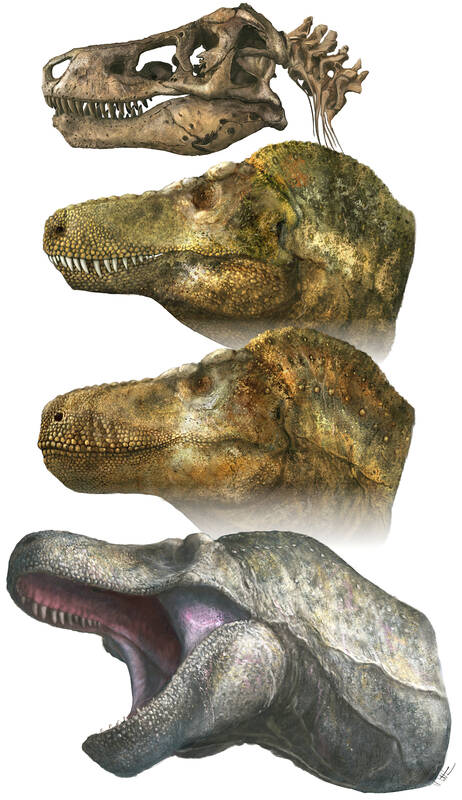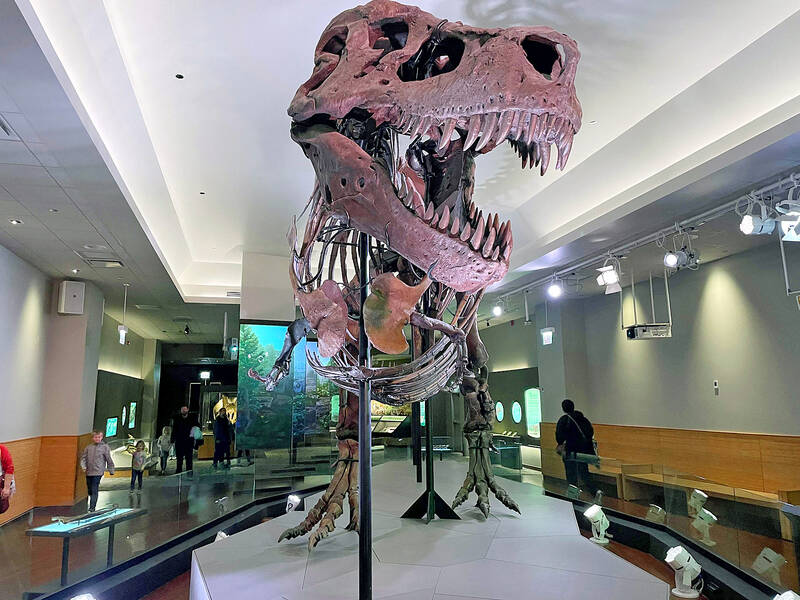They probably did not smile, frown or snarl, but T rex and its relatives almost certainly had the dinosaur equivalent of lips — a new finding by scientists that challenges popular depictions of these predators as having big nasty teeth sticking out of their mouths.
Researchers said on Thursday three lines of evidence — the skull and jaw anatomy in the group called theropods that encompassed all the meat-eating dinosaurs, the wear patterns of their teeth and the relationship between tooth size to skull size — all indicated the presence of lip-like structures.
“Our study suggests that theropod dinosaurs did not have exposed teeth when the mouth was closed,” said Auburn University paleontologist Thomas Cullen, lead author of the study published in the journal Science.

Photo: AP
“Dinosaur lips would be different from mammal lips in that they would cover the teeth but could not be moved independently — couldn’t be curled back into a snarl or make other sorts of movements we associate with lips in humans or other mammals. In this way, dinosaur lips would be more similar to those of many lizards or amphibians, even if we typically associate the structure and term with mammals like ourselves,” Cullen said.
These dino lips would have been a scaly counterpart to the kind with which people pucker up. They also would not technically be called lips, but rather “labial scales.”
Scientific and popular culture depictions of Tyrannosaurus and other meat-eating dinosaurs — think of the T. rex in the 1993 movie Jurassic Park — often have shown their teeth as exposed like those of crocodiles. In reality, the researchers said, the teeth likely were covered by soft facial tissues as with most land reptiles including Komodo dragons, the world’s largest lizard that inhabits certain Indonesian islands.

Photo: AFP
“Living monitor lizards like Komodo dragons are perfect living analogues — flesh-eating active predators with surprisingly similar teeth to that of dinosaurs,” said paleontologist and study co-author Robert Reisz of the University of Toronto Mississauga.
Dino lips offer several advantages.
“The full closure of their mouth with labial scale-covered lips protects the inside of the mouth — the oral cavity — against the dry terrestrial environment so that the usual oral environment — the oral glands, sensory organs and moist tongue — would be protected. This represents the normal biological condition for a terrestrial animal, while living crocs diverged from this pattern as they became predominantly aquatic or amphibious,” Reisz said.
Sealed lips would help saliva secretions in the mouth keep teeth, particularly the enamel, hydrated, Cullen said. If teeth are allowed to dry out, they become more prone to damage during feeding or fighting, Cullen added, not ideal if you are the fiercest fighter in the forest.
An examination of the relationship between tooth size and skull size undercut the idea that large theropods simply had teeth too big to be covered by lips. The study identified large lizard species with lips alive today that possess teeth proportionally bigger than T rex, relative to skull size.
In crocs, teeth show asymmetrical wear, with the side of the exposed teeth facing outward more beat up than the inner side. No such asymmetrical wear was detected when the scientists scrutinized exemplary tooth fossils of Daspletosaurus, a close cousin to T. rex, suggesting the presence of lips.
Finally, an examination of theropod skulls found evidence of small pits along the upper jaws that house nerves and blood vessels to supply lips and gums, structures lacking in crocs.
“We have a much more realistic interpretation of the facial features of theropods, important to understanding their biology,” Reisz said.
Cullen added, “What we are in many ways striving for here is for dinosaurs to be seen for what they actually were — animals — and not purely as movie monsters.”

Nine Taiwanese nervously stand on an observation platform at Tokyo’s Haneda International Airport. It’s 9:20am on March 27, 1968, and they are awaiting the arrival of Liu Wen-ching (柳文卿), who is about to be deported back to Taiwan where he faces possible execution for his independence activities. As he is removed from a minibus, a tenth activist, Dai Tian-chao (戴天昭), jumps out of his hiding place and attacks the immigration officials — the nine other activists in tow — while urging Liu to make a run for it. But he’s pinned to the ground. Amid the commotion, Liu tries to

A dozen excited 10-year-olds are bouncing in their chairs. The small classroom’s walls are lined with racks of wetsuits and water equipment, and decorated with posters of turtles. But the students’ eyes are trained on their teacher, Tseng Ching-ming, describing the currents and sea conditions at nearby Banana Bay, where they’ll soon be going. “Today you have one mission: to take off your equipment and float in the water,” he says. Some of the kids grin, nervously. They don’t know it, but the students from Kenting-Eluan elementary school on Taiwan’s southernmost point, are rare among their peers and predecessors. Despite most of

A pig’s head sits atop a shelf, tufts of blonde hair sprouting from its taut scalp. Opposite, its chalky, wrinkled heart glows red in a bubbling vat of liquid, locks of thick dark hair and teeth scattered below. A giant screen shows the pig draped in a hospital gown. Is it dead? A surgeon inserts human teeth implants, then hair implants — beautifying the horrifyingly human-like animal. Chang Chen-shen (張辰申) calls Incarnation Project: Deviation Lovers “a satirical self-criticism, a critique on the fact that throughout our lives we’ve been instilled with ideas and things that don’t belong to us.” Chang

The resignation of Taiwan People’s Party (TPP) co-founder Ko Wen-je (柯文哲) as party chair on Jan. 1 has led to an interesting battle between two leading party figures, Huang Kuo-chang (黃國昌) and Tsai Pi-ru (蔡壁如). For years the party has been a one-man show, but with Ko being held incommunicado while on trial for corruption, the new chair’s leadership could be make or break for the young party. Not only are the two very different in style, their backgrounds are very different. Tsai is a co-founder of the TPP and has been with Ko from the very beginning. Huang has